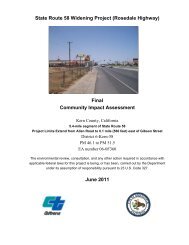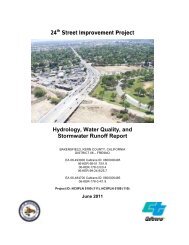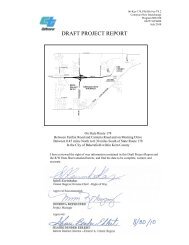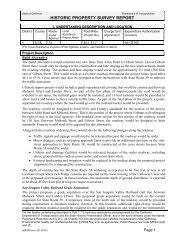State Route 58 Widening Project - Bakersfield Freeways
State Route 58 Widening Project - Bakersfield Freeways
State Route 58 Widening Project - Bakersfield Freeways
Create successful ePaper yourself
Turn your PDF publications into a flip-book with our unique Google optimized e-Paper software.
Chapter 4.<br />
Results: Biological<br />
Resources, Discussion of<br />
Impacts and Mitigation<br />
One federally listed species has potential to occur in the BSA: the San Joaquin kit<br />
fox. The following analysis covers background information on this species, the<br />
presence of this species in the BSA, Avoidance and Minimization Measures, project<br />
effects on the kit fox, compensatory mitigation, and cumulative effects of the TRIP<br />
projects.<br />
4.1. Federally Listed or Proposed Animal Species<br />
Occurrences<br />
4.1.1. Discussion of San Joaquin Kit Fox (Vulpes macrotis mutica)<br />
The San Joaquin kit fox is a federally listed endangered species and a <strong>State</strong>-listed<br />
threatened species. Kit foxes are primarily nocturnal, but can also be crepuscular or at<br />
times diurnal. Typically, they emerge at sunset to hunt prey such as kangaroo rats<br />
(Dipodomys sp.), black-tailed jackrabbits, desert cottontails, and California ground<br />
squirrels (Thomas Reid Associates 1994). San Joaquin kit foxes prefer open habitats<br />
such as grasslands and open scrubland (USFWS 1998). In the southernmost portion<br />
of their range, the kit fox is commonly associated with valley sink scrub, valley<br />
saltbush scrub, upper Sonoran subshrub scrub, and annual grassland (USFWS 1998).<br />
The species also inhabits grazed grasslands, petroleum fields, urban areas, and land<br />
adjacent to tilled or fallow fields (USFWS 1998). Kit foxes may also occasionally<br />
utilize agricultural lands, including croplands and orchards (Warrick et al. 2007),<br />
although areas that are routinely disturbed by agricultural practices have a limited<br />
capacity to support them.<br />
Kit foxes use dens throughout the year to rear pups, to avoid water loss and heat<br />
stress in summer, to minimize metabolic costs in winter, and to escape predation<br />
(USFWS 1998). While kit foxes prefer loose-textured soils for denning, they are<br />
found on virtually every soil type (<strong>Bakersfield</strong> and Caltrans 2010).<br />
The San Joaquin kit fox has historically occurred throughout most of the San Joaquin<br />
Valley from San Joaquin County in the north to Kern County in the south (USFWS<br />
<strong>State</strong> <strong>Route</strong> <strong>58</strong> <strong>Widening</strong> <strong>Project</strong> Biological Assessment 29








